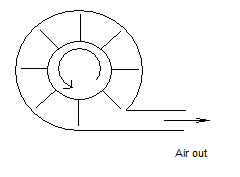I have always been fascinated by jet engines. Part of that fascination being that I could never understand how they could possibly work.
The basic description is that there is a big fan at the front to suck air into the engine. The air is used to burn fuel and is ejected out the back at high speed producing thrust. As it goes out the back it turns another fan.
The two fans are connected together so that the rear one drives the front one, sucking in more air.
How is that possible? Its like someone picking himself up by the bootstraps. How can the rear fan drive the the front one? Why doesn't it run backwards or just stop?
The answer is in the design of those fans.
The front one, (The compressor) is designed in such a way as to be very, very efficient at compressing air but very poor as a windmill.
Think of the type of fan used in leaf blowers. It looks like an old fashioned paddle wheel. As it spins it throws air out. That type is difficult to spin by blowing into it but very good at producing lots of fast-moving air.
This is exactly the type of compressor used in the first jet engine (invented by Frank Whittle) and it is still used in model jet engines today.
The rear one (The turbine) is designed to be good at spinning in the wind but poor at blowing air itself. The classic child's windmill is a good example.
In addition, the air is ducted and directed in such a way as to encourage it to move smoothly from front-to-rear of the engine while at the same time it is hindered from moving the other way.
The result is a sort of continuous 'ratchet'. As the air in the combustion zone expands with the heat, it finds itself faced with a 'wall' of compressed air in the front of the engine but a relatively easy escape out the back.
It has to get past the turbine, where it loses a bit of energy pushing it round, but that's only a tiny fraction of it's available power because the highly efficient compressor needs only a little to maintain that wall of gas.

5 comments:
Hi,
I have had exacly the same question in my mind for years (why doesn't the exploding air push forwards through the front as well forcing the engine to go the other way or stop) and your blog here has been the first to actually answer that question for me. Thanks very much. I notice your last post was in April. Hope to see what progress there has been since then.
No progress since April I'm afraid,
That forward/backward difference is so fine that the engineering tolerances are a serious problem.
I have a real slapdash approach. It works fine with most things - but not with this...
I've been hoping to get hold of a Turbocharger, which is a relatively easy shortcut for making a jet turbine. (NB. I say 'relatively').
If I can get one of those to work, maybe the experience will help with the main project.
But other things keep intruding - Work f'rinstance
hi i really appreciate your work im also making a turbojet but a big one so i need your help regarding the design of the combustion chamber or if u can illustrate it tnx
i would be very grateful if u can explain me how to design turbines
of compressor
I'd love to be able to help but I have a long way to go before I can make one work myself so I can't really advise on design. - Other than what I have already written in this Blog.
Post a Comment